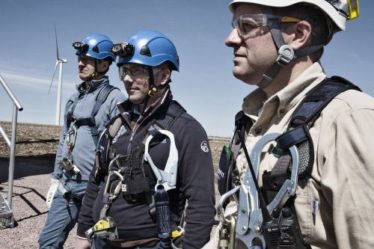.jpg)
According to a Wilderness Society analysis of U.S. Geological Survey data, life-cycle emissions from oil, gas and coal pulled from public lands and waters were equivalent to more than 20 percent of total U.S. greenhouse gas emissions in 2018. If those emissions were attributed to a single country, it would rank fifth in life-cycle emissions, a sobering fact that exposes the need for bold leadership at the helm of historically slow-moving federal agencies.
Early in his presidency, President Joe Biden made it a priority to select a diverse team proficient in climate work, and his cabinet appointment of Deb Haaland as Secretary for the Department of the Interior is no exception.
Born in Winslow, Arizona, Haaland spent summers with her grandmother in the Laguna Pueblo in Northwestern New Mexico and identifies as 35th generation Indigenous New Mexican with ties to the region dating back to the 13th century.
Haaland was one of the first Native women elected to Congress, representing New Mexico’s 1st congressional district, and her appointment to the Interior makes her the first Native person to lead a U.S. cabinet agency. This breaks a 245-year record of non-Native leadership in a department directly responsible for managing the relationship with the nation’s 574 tribes and the 50 million acres of Native land held in trust by Interior bureaus.
Haaland will oversee nearly 500 million acres of land — that’s one-fifth the land area of the U.S. and 70% of all public lands — and almost 700 million acres of natural resources that lay beneath it and its coasts.
As Interior Secretary, Haaland will oversee nearly 500 million acres of land — that’s one-fifth the land area of the U.S. and 70 percent of all public lands — and almost 700 million acres of natural resources that lay beneath it and its coasts. The department is responsible for 422 national parks, 129 national monuments and 567 wildlife refuges, stewarding biodiversity conservation projects and protecting more than 1,000 endangered species.
« It was in the cornfields with my grandfather where I learned the importance of water and protecting our resources and where I gained a deep respect for the earth, » Haaland said in her confirmation hearings, emphasizing that her experiences make her uniquely qualified to lead the Interior Department.
Climate advocates believe this is a significant turning point for the Interior, creating a pathway for private sector collaboration in the agency’s efforts to decarbonize and bolster federal production of renewable energy.
The Interior’s dirty fuel challenge
Given the sheer size of land and water under management, the Interior represents a valued powerhouse of domestic output and natural resource development. During Haaland’s confirmation hearings, Sen. Joe Manchin III (D-W.Va.) pointed out that the agency « generates $12 billion for treasury, $315 billion to the U.S. economy and nearly 2 million jobs, » a statement made to underline the importance of the department’s current and future operations.
In terms of resource development, Haaland inherits a department that produces the resources for 20 percent of U.S. energy, including 12 percent of its natural gas, 24 percent of its oil and 43 percent of its coal. Leases managed by the Interior hit a record 1 billion barrels in 2020 — a 23 percent increase from 2016 levels.
By contrast, sites primarily consisting of Bureau of Land Management projects — an Interior-managed department — produce only 1 percent of the country’s wind and virtually none of its solar power. Fossil fuels development on public lands and waters is responsible for almost one-quarter of the country’s emissions, according to a 2018 U.S. Geological Survey report, making public lands a net emitter of greenhouse gas and the subject of priority review by the Interior’s new leadership.
Public land-based solutions
As a valuable carbon sink, America’s public lands and waters are an essential part of a successful federal climate strategy, writes Alison Kelly, senior attorney at the Natural Resources Defense Council.
U.S. federal forests and grasslands are a major carbon pool and a significant component of the national greenhouse gas inventory, encompassing 248 million acres estimated to contain more than 12 billion tons of carbon.
Currently, the country’s 154 national forests absorb about 10 percent of the nation’s total carbon emissions each year, and a U.S. House of Representatives Special Select Committee on the Climate Crisis report states that there’s potential for capacity increases if deforestation is prevented, new forests are planted and agencies bring new lands into federal ownership.
There’s no question that fossil energy does and will continue to play a major role in America for years to come. But we must also recognize that the energy industry is innovating, and our climate challenge must be addressed.
According to the committee report, protecting and expanding federal « blue carbon systems » — those that include ocean and wetland ecosystems, including mangroves, seagrasses and marshes — are essential to offset department emissions since they store carbon at a faster rate than terrestrial forests, a finding likely to inform the Interior department’s emission reduction strategies.
The Interior’s bold to-do list
Historically, the agency has adhered to traditional notions of energy development, and Haaland has been an outspoken critic of that strategy. She was an early sponsor of the Green New Deal resolution in the House and has said she’s « wholeheartedly against fracking and drilling on public lands. »
As Secretary of the Interior, Haaland acknowledges that the role primarily consists of following the law and directives from the White House, not making them. « I understand that [my] role, it’s to serve all Americans, not just my one district in New Mexico, » said Haaland in her confirmation hearings.
To that point, while climate change has become a political tension point, Haaland has emerged as someone who can work effectively with colleagues across the aisle. During her first term in the House, she was named the most bipartisan freshman congresswoman, a trait seen as an asset in aiding efforts to transform the Interior department into a climate-positive entity and potential ally for private sector contractors in the renewable energy space.
During her confirmation hearings, Haaland was diplomatic and realistic. « There’s no question that fossil energy does and will continue to play a major role in America for years to come, » she told the committee. « But we must also recognize that the energy industry is innovating, and our climate challenge must be addressed. »
As Haaland settles into her new role, federal and private sector companies should look to the following key priorities for early indications on how business can expect to plug into achieving the administration’s ambitious goals.
1. Pausing new oil fossil fuel development
As directed in the recent Tackling the Climate Crisis at Home and Abroad executive order, the Interior has put a pause on new oil and natural gas leases pending the completion of a « comprehensive review and reconsideration of Federal oil and gas permitting and leasing practices. » This is seen as a bold step to systematically quantify climate impact, using it to inform future leasing processes.
2. Doubling offshore wind by 2030
As Secretary of the Interior, Haaland said she is committed to finding the right balance between economic growth and investing in a clean energy future.
« As part of this balance, the Department has a role in harnessing the clean energy potential of our public lands to create jobs and new economic opportunities, » she said. « The president’s agenda demonstrates that America’s public lands can and should be engines for clean energy production. »
To this end, Haaland will be responsible for reviewing opportunities to increase renewable energy production on Interior lands and waters, with the goal to double offshore wind by 2030. Currently, the Bureau of Ocean Energy Management — an Interior managed department — has 15 active commercial leases in various, early stages of development in the Atlantic which, if developed fully, have the potential to support more than 21 GW of energy generating capacity — enough to power almost 7.5 million homes
On a national scale, offshore wind for the contiguous United States and Hawaii has a potential capacity of 2,058 gigawatts, or 7,203 terawatt-hours per year, nearly double the electricity consumption of the U.S., according to the National Renewable Energy Laboratory’s 2016 Offshore Wind Resource Assessment for the United States report.
3. Creating jobs with the Civilian Climate Corps
Within 90 days, the Interior will submit « a strategy creating a Civilian Climate Corps Initiative, to mobilize the next generation of conservation and resilience workers and maximize the creation of accessible training opportunities and good jobs, » as directed by the executive order, and Haaland is fully onboard.
The creation of a Civilian Climate Corps « demonstrates that America’s public lands can and should be engines for clean energy production » and « has the potential to spur job creation, » Haaland said during her confirmation hearings.
4. Centering equity and environmental justice
« Communities of color, low-income families, and rural and Indigenous communities have long suffered disproportionate and cumulative harm from air pollution, water pollution, and toxic sites, » states the Interior’s recently updated priorities list.
As a Congresswoman, and through her lived experiences with Indigenous communities, Haaland says she understands that negative environmental and social impacts are not evenly distributed in our society. As leader of the Interior, and a new member of the White House Environmental Justice Interagency Council, she will be held accountable for addressing environmental injustice in accordance with Biden’s executive order directing the Interior to provide a comprehensive justice strategy and performance metrics.
A fierce new climate ally
With the confirmation of Haaland as Secretary of the Interior, government leaders, activists and businesses expect to see major disruptions to business-as-usual public lands management. Haaland will be tasked with preserving natural spaces for generations to come, reducing the department’s sizable environmental impact and reorienting a team of 70,000 employees. While her supporters expect her to be strong on climate action, her skeptics expect her to listen and work with them, something that she says she’s willing and able to do.
In an open letter to Senate leaders during Haaland’s confirmation hearings — signed by nearly 500 national and regional organizations representing Native communities, environmental justice groups and private sector businesses — Haaland was described as « a proven leader and the right person to lead the charge against the existential threats of our time: tackling the climate, biodiversity, extinction and COVID-19 crises and racial justice inequities on our federal public lands and waters. »
At the helm of the Interior, Haaland will play a central role in realizing the federal government’s promises to combat climate change, deploy clean energy and address environmental racism.


